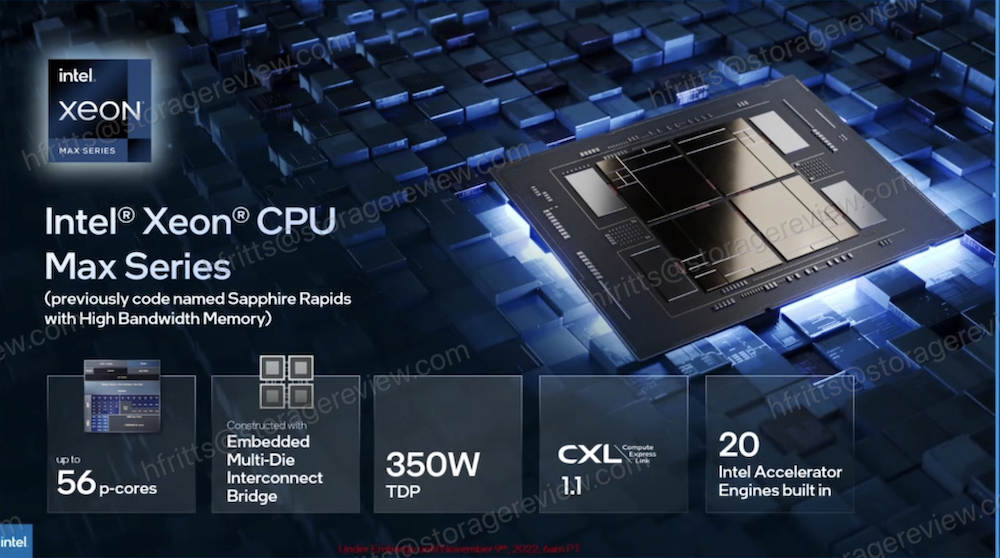Intel beat the SC 22 rush by introducing the Intel Max Series product family focused on HPC and AI. The Intel Xeon CPU Max Series (code-named Sapphire Rapids HBM) and Intel Data Center GPU Max Series (Code-named Ponte Vecchio) will power the upcoming Aurora supercomputer at Argonne National Laboratory.
Intel beat the SC 22 rush by introducing the Intel Max Series product family focused on HPC and AI. The Intel Xeon CPU Max Series (code-named Sapphire Rapids HBM) and Intel Data Center GPU Max Series (Code-named Ponte Vecchio) will power the upcoming Aurora supercomputer at Argonne National Laboratory.

The new Intel Max family of products is said to deliver 4.8x faster CPU memory bandwidth than the competition and Intel’s highest-density GPU. The Xeon Max CPU is the only x86-based processor with high bandwidth memory, accelerating many HPC workloads without requiring code changes. The Max Series GPU is Intel’s highest-density processor, packing over 100 billion transistors into a 47-tile package with up to 128 gigabytes (GB) of high-bandwidth memory.
The new family of products is supported by Intel’s oneAPI, an open software ecosystem that provides a single programming environment for both new processors. Intel’s 2023 oneAPI and AI tools will deliver capabilities to enable the Intel Max Series products’ advanced features.
Jeff McVeigh, Corporate Vice President and General Manager, Super Compute Group at Intel, said:
“To ensure no HPC workload is left behind, we need a solution that maximizes bandwidth, maximizes
compute, maximizes developer productivity, and ultimately maximizes impact. The Intel Max Series
product family brings high bandwidth memory to the broader market, along with oneAPI, making it easy
to share code between CPUs and GPUs and solve the world’s biggest challenges faster.”
GPU blades to Argonne, CPU blades to Los Alamos
The Max Series products are slated to launch in January 2023, but is already shipping blades with Max Series GPUs to Argonne National Laboratory to power the Aurora supercomputer and will deliver Xeon Max CPUs to Los Alamos National Laboratory, Kyoto University, and other supercomputing sites.

The Xeon Max CPU offers up to 56 performance cores constructed of four tiles and connected using Intel’s embedded multi-die interconnect bridge (EMIB) technology in a 350-watt envelope. Xeon Max CPUs contain 64GB of high bandwidth in-package memory and PCI Express 5.0 and CXL1.1. Xeon Max CPUs will provide more than 1GB of high bandwidth memory (HBM) capacity per core, enough to fit most common HPC workloads. Other benefits of the Max Series CPU include the following:
- 68% less power usage than an AMD Milan-X cluster for the same HCPG performance.
- AMX extensions boost AI performance and deliver 8x peak throughput over AVX-512 for INT8 with INT32 accumulation operations.
- It provides flexibility to run in different HBM and DDR memory configurations.
- Workload benchmarks:
- Climate modeling: 2.4x faster than AMD Milan-X on MPAS-A using only HBM.
- Molecular dynamics: On DeePMD, 2.8x performance improvement against competing
products with DDR memory.

The Max Series GPUs deliver up to 128 Xe-HPC cores targeted at the most demanding computing workloads. Additionally, the Max Series GPU features:
- 408MB of L2 cache – the highest in the industry – and 64MB of L1 cache to increase throughput
and performance. - The only HPC/AI GPU with native ray tracing acceleration designed to speed scientific
visualization and animation. - Workload benchmarks:
- Finance: 2.4x performance gain over NVIDIA’s A100 on Riskfuel credit option pricing.
- Physics: 1.5x improvement over A100 for NekRS virtual reactor simulations.
Max Series GPUs will be available in several form factors to address different customer needs:
- Max Series 1100 GPU: A 300-watt double-wide PCIe card with 56 Xe cores and 48GB of HBM2e memory. Multiple cards can be connected via Intel Xe Link bridges.
- Max Series 1350 GPU: A 450-watt OAM module with 112 Xe cores and 96GB of HBM.
- Max Series 1550 GPU: Intel’s maximum performance 600-watt OAM module with 128 Xe cores and 128GB of HBM.
In addition to individual cards and modules, Intel will offer the Intel Data Center GPU Max Series subsystem with x4 GPU OAM carrier board and Intel Xe Link to enable high-performance multi-GPU communication within the subsystem.
The Aurora supercomputer, currently under construction at Argonne National Laboratory, will become the first supercomputer to exceed 2 exaflops of peak double-precision compute performance. Aurora will also be the first to showcase pairing Max Series GPUs and CPUs in a single system, with more than 10,000 blades, each containing six Max Series GPUs and two Xeon Max CPUs.
Argonne and Intel unveil Sunspot
In another pre-SC22 announcement, Argonne and Intel unveiled Sunspot, Aurora’s Test Development System consisting of 128 production blades. Researchers from the Aurora Early Science Program will have access to the system beginning in late 2022.
There will be more to see at SC22, where Intel and its customers will showcase more than 40 upcoming system designs from 12 OEMs using Max Series products. Demos will showcase the performance and capability of Max Series products for a range of AI and HPC applications. Intel architects, customers, and end-users will deliver presentations about the power of Intel’s platform solutions at Intel booth #2428.
There’s more to come for Max Series
The Intel Data Center Max Series GPU, code-named Rialto Bridge, is the successor to the Max Series GPU and is intended to arrive in 2024 with improved performance and a seamless path to upgrade. Intel is then planning to release the next major architecture innovation to enable the future of HPC. Intel’s upcoming XPU, code-named Falcon Shores, will combine Xe and x86 cores on a single package. This new architecture will also have the flexibility to integrate new IPs from Intel and customers.
Engage with StorageReview
Newsletter | YouTube | Podcast iTunes/Spotify | Instagram | Twitter | TikTok | RSS Feed
